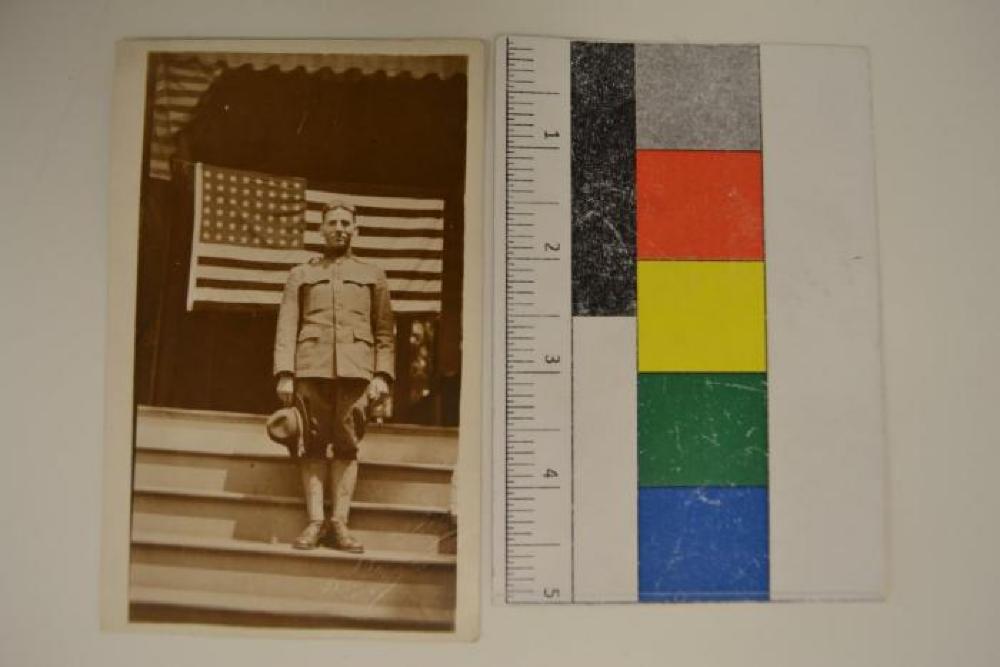Object ID
1998.22.4
Object Name
Photograph
Object Collection
George Phillos Photograph Collection (is part of)
Date Created
1917 – 1918
Medium
black and white photograph
Object Entities
Related Items
Access Points
Object Description
Sepia toned postcard photograph of a young man in military uniform standing in front of the American flag.
At the top of the photo, a striped bunting and a scalloped curtain frame the top of the stage area. Dark theater curtains create a dramatic backdrop for the American flag which is hung in front of them unfurled. Four stairs are visible coming down from the stage in the photo. The young man stands slightly off center on the third stair down, facing the camera with heels together and toes apart.
The young man has a slight smile. He is wearing an Army uniform-- a button-down jacket, tapered trousers, boots and canvas puttees. He is holds his "Montana peak" campaign hat at his right side (image's left).
The photograph is printed on a postcard. In the bottom right corner, it is embossed with a diagonal stamp that reads "The Star Studio" in elegant font and "BLOOMINGTON" in block print below.
At the top of the photo, a striped bunting and a scalloped curtain frame the top of the stage area. Dark theater curtains create a dramatic backdrop for the American flag which is hung in front of them unfurled. Four stairs are visible coming down from the stage in the photo. The young man stands slightly off center on the third stair down, facing the camera with heels together and toes apart.
The young man has a slight smile. He is wearing an Army uniform-- a button-down jacket, tapered trousers, boots and canvas puttees. He is holds his "Montana peak" campaign hat at his right side (image's left).
The photograph is printed on a postcard. In the bottom right corner, it is embossed with a diagonal stamp that reads "The Star Studio" in elegant font and "BLOOMINGTON" in block print below.
Origin
George Phillos was born in 1893 in Greece. He served in the U.S. Army during World War I, and afterward joined the American Legion.
According to the 1940 Census, he lived at that time with his sister and brother-in-law, Harry and Catherine Secaras and their children John and Helen in Chicago. George Phillos' nephew, John Secaras, donated this photograph to the National Hellenic Museum along with his Army uniform.
In this photograph, Phillos is wearing an Army enlisted uniform with button-down jacket, tapered trousers, ankle boots, and canvas puttees. He is holding a "Montana peak" campaign hat. The stage behind him appears to be decorated for some sort of ceremony. It might have been Phillos' basic training graduation ceremony. The photograph is printed on a memento postcard.
Photograph postcards were invented by Kodak in 1903. The No. 3A Folding Pocket Kodak camera was designed for postcard-size film and allowed people to take photographs and have them printed on postcard backs. In 1907, Kodak created a service called “Real Photo postcards” enabling people to make a postcard from any picture they took. That same year the U.S. Postal Service began allowing written messages on the back of penny postcards in addition to the address. This postcard has space for "correspondence" and "address" on the back. Later, a vertical line was added splitting postcard backs in half, with space for the message on the left and the address on the right. "Real Photo" postcards soared in popularity in America, and many people began collecting the cards in albums. No other format has provided such a massive photo history of America, particularly small-town and rural America where photography was often a luxury.
According to the 1940 Census, he lived at that time with his sister and brother-in-law, Harry and Catherine Secaras and their children John and Helen in Chicago. George Phillos' nephew, John Secaras, donated this photograph to the National Hellenic Museum along with his Army uniform.
In this photograph, Phillos is wearing an Army enlisted uniform with button-down jacket, tapered trousers, ankle boots, and canvas puttees. He is holding a "Montana peak" campaign hat. The stage behind him appears to be decorated for some sort of ceremony. It might have been Phillos' basic training graduation ceremony. The photograph is printed on a memento postcard.
Photograph postcards were invented by Kodak in 1903. The No. 3A Folding Pocket Kodak camera was designed for postcard-size film and allowed people to take photographs and have them printed on postcard backs. In 1907, Kodak created a service called “Real Photo postcards” enabling people to make a postcard from any picture they took. That same year the U.S. Postal Service began allowing written messages on the back of penny postcards in addition to the address. This postcard has space for "correspondence" and "address" on the back. Later, a vertical line was added splitting postcard backs in half, with space for the message on the left and the address on the right. "Real Photo" postcards soared in popularity in America, and many people began collecting the cards in albums. No other format has provided such a massive photo history of America, particularly small-town and rural America where photography was often a luxury.
Rights and Reproduction
The content on this site is made available for research and education purposes only. The use of these materials may be restricted by law or the donor.
Any other use, such as exhibition, publication, or commercial use, is not allowed except by written permission in accordance with the NHM Image Rights and Reproduction Policy.
For questions on image rights and reproduction, please contact nhmcollections@hellenicmuseum.org
Any other use, such as exhibition, publication, or commercial use, is not allowed except by written permission in accordance with the NHM Image Rights and Reproduction Policy.
For questions on image rights and reproduction, please contact nhmcollections@hellenicmuseum.org
Citation
Photograph, 1917 – 1918, George Phillos Photograph Collection, National Hellenic Museum, https://hellenic.whirlihost.com/Detail/objects/4700. Accessed 04/18/24.
